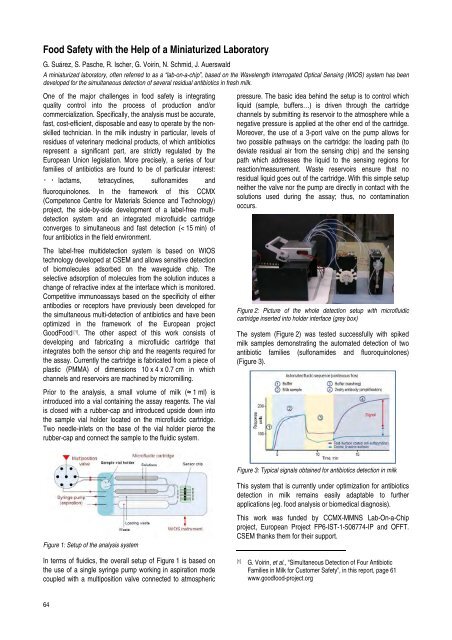research activities in 2007 - CSEM
research activities in 2007 - CSEM
research activities in 2007 - CSEM
Create successful ePaper yourself
Turn your PDF publications into a flip-book with our unique Google optimized e-Paper software.
Food Safety with the Help of a M<strong>in</strong>iaturized Laboratory<br />
G. Suárez, S. Pasche, R. Ischer, G. Voir<strong>in</strong>, N. Schmid, J. Auerswald<br />
A m<strong>in</strong>iaturized laboratory, often referred to as a “lab-on-a-chip”, based on the Wavelength Interrogated Optical Sens<strong>in</strong>g (WIOS) system has been<br />
developed for the simultaneous detection of several residual antibiotics <strong>in</strong> fresh milk.<br />
One of the major challenges <strong>in</strong> food safety is <strong>in</strong>tegrat<strong>in</strong>g<br />
quality control <strong>in</strong>to the process of production and/or<br />
commercialization. Specifically, the analysis must be accurate,<br />
fast, cost-efficient, disposable and easy to operate by the nonskilled<br />
technician. In the milk <strong>in</strong>dustry <strong>in</strong> particular, levels of<br />
residues of veter<strong>in</strong>ary medic<strong>in</strong>al products, of which antibiotics<br />
represent a significant part, are strictly regulated by the<br />
European Union legislation. More precisely, a series of four<br />
families of antibiotics are found to be of particular <strong>in</strong>terest:<br />
・・lactams, tetracycl<strong>in</strong>es, sulfonamides and<br />
fluoroqu<strong>in</strong>olones. In the framework of this CCMX<br />
(Competence Centre for Materials Science and Technology)<br />
project, the side-by-side development of a label-free multidetection<br />
system and an <strong>in</strong>tegrated microfluidic cartridge<br />
converges to simultaneous and fast detection (< 15 m<strong>in</strong>) of<br />
four antibiotics <strong>in</strong> the field environment.<br />
The label-free multidetection system is based on WIOS<br />
technology developed at <strong>CSEM</strong> and allows sensitive detection<br />
of biomolecules adsorbed on the waveguide chip. The<br />
selective adsorption of molecules from the solution <strong>in</strong>duces a<br />
change of refractive <strong>in</strong>dex at the <strong>in</strong>terface which is monitored.<br />
Competitive immunoassays based on the specificity of either<br />
antibodies or receptors have previously been developed for<br />
the simultaneous multi-detection of antibiotics and have been<br />
optimized <strong>in</strong> the framework of the European project<br />
GoodFood [1] . The other aspect of this work consists of<br />
develop<strong>in</strong>g and fabricat<strong>in</strong>g a microfluidic cartridge that<br />
<strong>in</strong>tegrates both the sensor chip and the reagents required for<br />
the assay. Currently the cartridge is fabricated from a piece of<br />
plastic (PMMA) of dimensions 10 x 4 x 0.7 cm <strong>in</strong> which<br />
channels and reservoirs are mach<strong>in</strong>ed by micromill<strong>in</strong>g.<br />
Prior to the analysis, a small volume of milk (≈ 1 ml) is<br />
<strong>in</strong>troduced <strong>in</strong>to a vial conta<strong>in</strong><strong>in</strong>g the assay reagents. The vial<br />
is closed with a rubber-cap and <strong>in</strong>troduced upside down <strong>in</strong>to<br />
the sample vial holder located on the microfluidic cartridge.<br />
Two needle-<strong>in</strong>lets on the base of the vial holder pierce the<br />
rubber-cap and connect the sample to the fluidic system.<br />
Figure 1: Setup of the analysis system<br />
In terms of fluidics, the overall setup of Figure 1 is based on<br />
the use of a s<strong>in</strong>gle syr<strong>in</strong>ge pump work<strong>in</strong>g <strong>in</strong> aspiration mode<br />
coupled with a multiposition valve connected to atmospheric<br />
64<br />
pressure. The basic idea beh<strong>in</strong>d the setup is to control which<br />
liquid (sample, buffers…) is driven through the cartridge<br />
channels by submitt<strong>in</strong>g its reservoir to the atmosphere while a<br />
negative pressure is applied at the other end of the cartridge.<br />
Moreover, the use of a 3-port valve on the pump allows for<br />
two possible pathways on the cartridge: the load<strong>in</strong>g path (to<br />
deviate residual air from the sens<strong>in</strong>g chip) and the sens<strong>in</strong>g<br />
path which addresses the liquid to the sens<strong>in</strong>g regions for<br />
reaction/measurement. Waste reservoirs ensure that no<br />
residual liquid goes out of the cartridge. With this simple setup<br />
neither the valve nor the pump are directly <strong>in</strong> contact with the<br />
solutions used dur<strong>in</strong>g the assay; thus, no contam<strong>in</strong>ation<br />
occurs.<br />
Figure 2: Picture of the whole detection setup with microfluidic<br />
cartridge <strong>in</strong>serted <strong>in</strong>to holder <strong>in</strong>terface (grey box)<br />
The system (Figure 2) was tested successfully with spiked<br />
milk samples demonstrat<strong>in</strong>g the automated detection of two<br />
antibiotic families (sulfonamides and fluoroqu<strong>in</strong>olones)<br />
(Figure 3).<br />
Figure 3: Typical signals obta<strong>in</strong>ed for antibiotics detection <strong>in</strong> milk<br />
This system that is currently under optimization for antibiotics<br />
detection <strong>in</strong> milk rema<strong>in</strong>s easily adaptable to further<br />
applications (eg. food analysis or biomedical diagnosis).<br />
This work was funded by CCMX-MMNS Lab-On-a-Chip<br />
project, European Project FP6-IST-1-508774-IP and OFFT.<br />
<strong>CSEM</strong> thanks them for their support.<br />
[1] G. Voir<strong>in</strong>, et al., “Simultaneous Detection of Four Antibiotic<br />
Families <strong>in</strong> Milk for Customer Safety”, <strong>in</strong> this report, page 61<br />
www.goodfood-project.org








